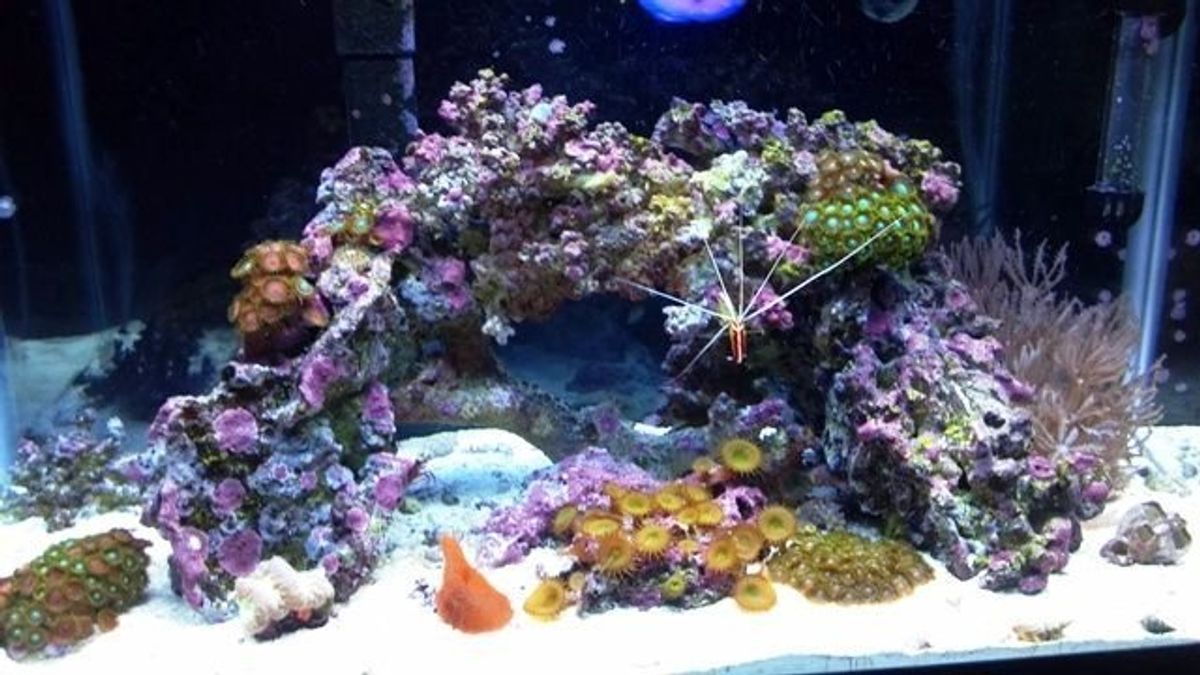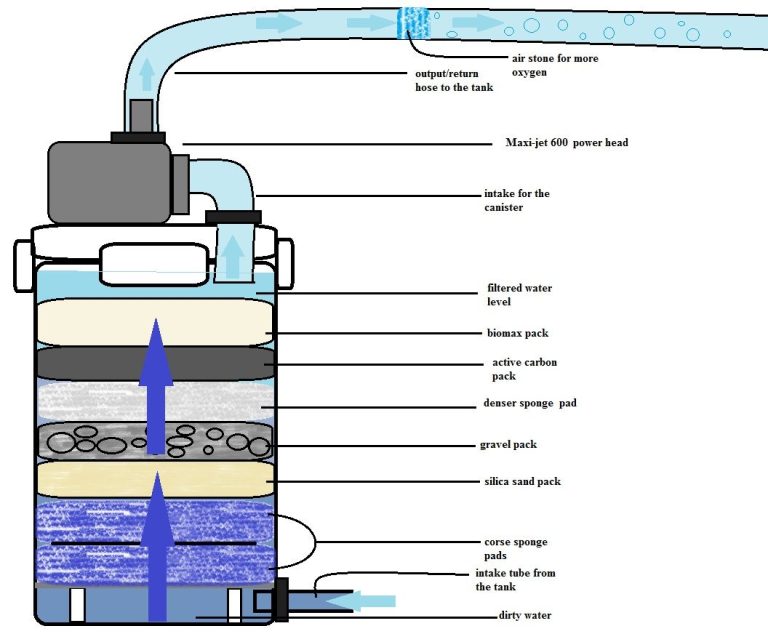How Much Live Rock Per Gallon Secrets Revealed
The general rule of thumb is to have 1 to 1.5 pounds of live rock per gallon of water in the aquarium. Live rock is an essential component in saltwater aquariums as it provides biological filtration and creates a natural environment for marine life to thrive.
Live rock serves as the main source of beneficial bacteria, which helps to maintain ideal water conditions by converting harmful nitrogen compounds into less toxic forms. It is also a habitat for micro and macroorganisms, which provide a source of natural food for marine animals.
The amount of live rock needed per gallon depends on the tank size, the type of marine life, and the aquarist’s preference. In this article, we will discuss how to determine the amount of live rock per gallon and why it is essential for a healthy aquarium.

Credit: www.nytimes.com
What Is Live Rock?
Live rock is a crucial element in any saltwater aquarium, as it helps to maintain a healthy and stable aquatic ecosystem. Live rock is a type of porous limestone that is harvested from the ocean and used in aquariums to provide a natural filtration system and habitat for marine life.
In this section, we will define live rock, discuss the differences between live rock and dry rock, and explore the benefits of using live rock in your aquarium.
Definition Of Live Rock
Live rock is a type of rock that is harvested from the ocean and used in aquariums to create a natural filtration system. It is made up of porous limestone that is home to a variety of microorganisms, including bacteria, algae, and other small creatures.
These microorganisms help to break down waste and maintain a stable environment for marine life.
Differences Between Live Rock And Dry Rock
Dry rock is a less expensive alternative to live rock that is often used in aquariums. While dry rock may look similar to live rock, it does not contain the same population of beneficial microorganisms. Dry rock must be “seeded” with live bacteria in order to create a suitable environment for marine life.
Some other key differences between live rock and dry rock include:
- Live rock is more expensive than dry rock
- Live rock is heavier than dry rock due to the presence of water and microorganisms
- Live rock may require curing before it can be used in an aquarium, whereas dry rock does not
- Live rock can have a more varied and visually appealing appearance than dry rock
How Live Rock Benefits The Aquarium
Live rock can offer a variety of benefits to your aquarium, including:
- Natural filtration: Live rock contains beneficial bacteria that break down waste and help to maintain a stable, healthy environment for marine life.
- Alkalinity buffer: The calcium carbonate in live rock can help to regulate ph and help to maintain alkalinity levels in your aquarium.
- Habitat: Live rock can provide a natural habitat for marine life by offering hiding places, perches, and other features that mimic the natural environment of the ocean.
- Aesthetics: Live rock can add visual interest and create a more natural-looking environment in your aquarium.
Overall, incorporating live rock into your saltwater aquarium can significantly improve the health and vitality of your aquatic ecosystem, leading to happier, healthier fish and other marine life.
How Much Live Rock Is Needed?
How much live rock per gallon secrets revealed: factors that affect the amount of live rock needed
When setting up a new aquarium, one of the essential decisions to make is how much live rock to include. The amount of live rock in a tank is crucial as it will affect the overall balance of the ecosystem.
###factors that affect the amount of live rock needed will help you understand how much live rock is required for your setup.
Factors That Affect The Amount Of Live Rock Needed
- Tank size: How much live rock you need for your tank depends on the size of your aquarium. Larger tanks generally require more live rock to ensure adequate biological filtration.
- Type of creatures: Different creatures have varying space requirements and need different hiding spaces. Therefore, the size and amount of live rock will depend on the types of creatures you plan to keep in your tank.
- Level of filtration: The amount of live rock needed will also depend on the desired level of filtration. The more live rock you have, the more effective your biological filtration will be, but it also means you’ll have to clean it more frequently.
Rule Of Thumb For Estimating Live Rock Requirements
There are no hard and fast rules when it comes to determining how much live rock to use. However, it’s a general rule of thumb that beginners use one pound of live rock per gallon of water. This estimate will give a good starting point, but it’s essential to note that amounts may vary depending on the specific factors of your aquarium.
Before adding any live rock to your aquarium, ensure you rinse it with clean saltwater to remove any debris or unwanted pests.
The amount of live rock needed for your aquarium depends on several factors, including tank size, type of creatures, and the desired level of filtration. The rule of thumb is to use one pound of live rock per gallon of water, but this may vary based on the specific conditions and needs of your tank.
By following these guidelines, you can ensure that your aquarium is optimal for your aquatic friends.
Advantages Of Using Live Rock
Using live rock in marine aquariums: advantages of using live rock
If you’re planning to create a marine aquarium, one material that you should consider using is live rock. This type of rock is not only aesthetically pleasing but also provides several benefits for your aquarium. Below are some advantages of using live rock in your marine aquarium:
Biological Filtration Properties Of Live Rock
Live rock is an excellent tool for biological filtration in your aquarium. Here’s why:
- Live rock is porous, which means it has a vast surface area for beneficial bacteria to attach to. These bacteria help convert harmful chemical compounds, such as ammonia and nitrites, into less harmful nitrates.
- The bacteria living in the live rock also consume organic waste produced by the fish and other organisms in the aquarium.
- Live rock can also help stabilize ph levels in your aquarium by absorbing acidic compounds.
- Overall, the biological filtration properties of live rock can help maintain excellent water quality in your marine aquarium.
Natural Look And Feel Of Live Rock In Aquariums
One of the most significant advantages of live rock is how it enhances the look and feel of your aquarium. Here are some reasons why:
- Live rock comes in various shapes and sizes, so you can create a unique and natural-looking aquarium.
- The surface of live rock can often have encrusting organisms, such as sponges, corals, and algae, which can add color and texture to your aquarium.
- The natural look and feel of live rock can also help fish and other organisms feel more at home in your aquarium.
Compatibility Of Live Rock With Other Marine Organisms
Another advantage of live rock is that it’s compatible with various marine organisms. Here are some reasons why:
- Live rock can help create microhabitats for various marine organisms, such as shrimp, crabs, and other invertebrates.
- Some fish species, such as clownfish, need live rock to live and breed in captivity.
- Live rock can also help provide hiding places and shelter for fish and other organisms.
Overall, using live rock in your marine aquarium can provide multiple benefits. It helps with biological filtration, improves the look and feel of your aquarium, and is compatible with various marine organisms. Consider using live rock when building your marine aquarium, and you’ll see a vast improvement in your aquarium’s health and aesthetics.
Ways To Incorporate Live Rock In Aquariums
Types Of Live Rock Available In The Market
There are several types of live rock available in the market. It is important to understand their characteristics before choosing one for your aquarium. Here are some of the most popular types of live rock:
- Fiji live rock: This rock is known for its unique shape and size. It has a beige to purple color and is covered in coralline algae. It is a great choice for reef aquariums and enhances the aesthetic appeal.
- Tonga live rock: This rock is known for its natural, irregular shapes. It has a grey color and is porous, making it an ideal habitat for microorganisms. It is perfect for creating a natural-looking aquascape.
- Marco rock: This rock is a man-made alternative to natural live rock. It is lightweight and porous, making it easy to work with and a good choice for aquascaping. It is available in different shapes and sizes and requires less curing time.
Choosing The Right Shape And Size For Your Aquarium
Choosing the right shape and size of live rock is important for creating a visually appealing aquascape and providing a suitable habitat for your aquatic creatures. Here are some tips:
- Select live rock that is appropriate for the size of your aquarium. As a general rule of thumb, use one to two pounds of live rock per gallon of water.
- Choose live rock that has a variety of shapes and sizes to create a natural-looking aquascape. Consider using larger pieces of rock for the back of the tank and smaller pieces for the front.
- Avoid using live rock with sharp edges or loose pieces that may harm your aquatic creatures. It is also important to use cured live rock to prevent toxins from leaching into your aquarium.
How To Arrange Live Rock To Create An Appealing Aquascape
Live rock plays a significant role in the overall aesthetics of your aquarium. Here are some tips for arranging live rock to create an appealing aquascape:
- Start by placing the larger pieces of live rock in the back of the tank and the smaller pieces in the front. This creates a natural-looking depth and dimension.
- Use live rock to create caves and hiding places for your aquatic creatures. This provides a sense of security and helps reduce stress.
- Use different types of live rock to create texture and contrast. Consider using different colors and shapes to create a visually appealing aquascape.
- Avoid overcrowding your aquarium with live rock. Leave enough space for your aquatic creatures to swim and move around.
Live rock aquarium design is an important aspect of creating a beautiful and healthy aquarium. By choosing the right type, shape, and size of live rock, and arranging it strategically, you can create an aquarium that is visually appealing and suitable for your aquatic creatures.
Caring For Live Rock
Caring For Live Rock In Aquariums
Live rock is an essential element when it comes to aquariums. It provides biological filtration, improves water quality and maintains a healthy environment for your marine organisms. But how much live rock per gallon is needed? In this blog, we will discuss caring for live rock and provide you with essential tips to ensure that both you and your marine creatures enjoy a healthy and thriving aquarium.
Avoiding Common Mistakes When Handling Live Rock
Live rock is delicate, and handling it requires care and attention, especially when integrating it into the aquarium for the first time. Here are the common mistakes to avoid when handling live rock.
- Touching live rock with bare hands can transfer bacteria and oil from your skin to the rock, potentially killing beneficial bacteria. Always wear gloves when handling live rock.
- Placing live rock directly into a new aquarium can cause ammonia spikes. Before adding live rock, ensure that the aquarium has completed the nitrogen cycle, or you have added bacterial supplements to the aquarium water.
- Overcrowding your aquarium with live rock can create dead zones. Ensure there is sufficient water circulation to avoid stagnant areas and prevent low-oxygen regions.
Proper Maintenance Practices For Live Rock
Live rock maintenance is essential to ensure your aquarium remains healthy. Here are some tips on how to properly maintain your live rock:
- Replace old live rock regularly with new pieces to prevent the build-up of debris and dead zones. Remove decaying matter from the aquarium daily, using a siphon or aquarium vacuum.
- Ensure that the ph and salinity levels of the aquarium are balanced by monitoring and testing the water regularly.
- Occasionally, move live rock to different areas of the aquarium to improve water circulation, prevent dead zones, and promote healthy growth.
Cleaning Live Rock And Avoiding Excessive Die-Off
Over time, live rock can become dirty and develop dead spots, leading to excessive die-off. Here’s how to clean live rock and avoid excessive die-off:
- Avoid using chemical cleaners or scrubbers to clean live rock as it can kill beneficial bacteria, which can lead to ammonia spikes.
- Use a soft-bristle brush or toothbrush to gently remove debris from the live rock’s surface.
- If the live rock has excessive die-off, remove it from the aquarium and allow it to dry out in the sun. Once dry, scrub off any dead or decaying matter before placing it back into the aquarium.
Caring for live rock in aquariums is essential to maintain a healthy and thriving marine environment. By following these essential tips on how to handle, maintain, and clean live rock, you can ensure that your marine creatures remain healthy and happy in their home.
Frequently Asked Questions Of How Much Live Rock Per Gallon
How Much Live Rock Should I Have Per Gallon Of Water?
A good rule of thumb is to have one pound of live rock for every gallon of water in your aquarium.
Why Is Live Rock Important In A Saltwater Aquarium?
Live rock serves as a biological filter, helping to maintain water quality and providing a natural environment for marine life.
Can I Have Too Much Live Rock In My Aquarium?
Yes, having too much live rock can cause problems with water flow, oxygen levels, and the balance of bacteria and other organisms in the tank.
How Do I Know If I Have Enough Live Rock In My Aquarium?
Check the water parameters and test for nitrate levels. If nitrate levels are high, you may need more live rock to help reduce them.
Conclusion
Based on the fish species and your personal preferences, the amount of live rock per gallon in an aquarium can vary. However, it is generally recommended to add about 1-2 pounds of live rock per gallon for a healthy and thriving aquatic environment.
As live rock serves as a natural filtration system, it helps in maintaining the appropriate levels of nitrate, nitrite, and ammonia in the water. It also acts as a habitat for beneficial bacteria, invertebrates, and marine life. Live rock is a significant investment for any aquarium enthusiast, but it is worth the price for the health and longevity of your aquatic ecosystem.
To ensure the best results, it is crucial to maintain a balance between the amount of live rock and other components in your aquarium, such as lighting, water circulation, and filtration. Always remember to monitor the quality of your water regularly and adjust the amount of live rock accordingly.






